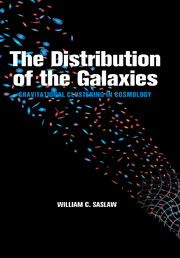Book contents
- Frontmatter
- Contents
- Prologue
- Part I Historical
- Part II Descriptions of Clustering
- Part III Gravity and Correlation Functions
- Part IV Gravity and Distribution Functions
- Part V Computer Experiments for Distribution Functions
- Part VI Observations of Distribution Functions
- Part VII Future Unfoldings
- Bibliography
- Index
Part II - Descriptions of Clustering
Published online by Cambridge University Press: 19 January 2010
- Frontmatter
- Contents
- Prologue
- Part I Historical
- Part II Descriptions of Clustering
- Part III Gravity and Correlation Functions
- Part IV Gravity and Distribution Functions
- Part V Computer Experiments for Distribution Functions
- Part VI Observations of Distribution Functions
- Part VII Future Unfoldings
- Bibliography
- Index
Summary
Quick and capacious computers, increasing realization of the importance of largescale structure, and the first glimpses into related many-body physics all combined to change our understanding of galaxy clustering in the early 1970s. So with our historical perspective concluded (though never complete) we now change our approach and describe selected ways to characterize the galaxy distribution. With the large, automatically analyzed catalogs now available, there is no lack of positional data. Successful new observational techniques are also providing many galaxy redshifts, which are being refined into peculiar velocities relative to the general expansion. Nor is there any lack of statistical techniques for analyzing the data. Dozens of quantitative descriptions, many based on analogies in subjects ranging from archaeology to zoology, have been proposed. The main problem is to select those which give most insight into the physical causes of the structure we see. In the next chapters, I sketch several examples, their strengths and weaknesses, and some of their accomplishments. It helps provide a perspective for the two descriptions that will dominate subsequent chapters: correlation functions and distribution functions.
- Type
- Chapter
- Information
- The Distribution of the GalaxiesGravitational Clustering in Cosmology, pp. 55 - 56Publisher: Cambridge University PressPrint publication year: 1999

